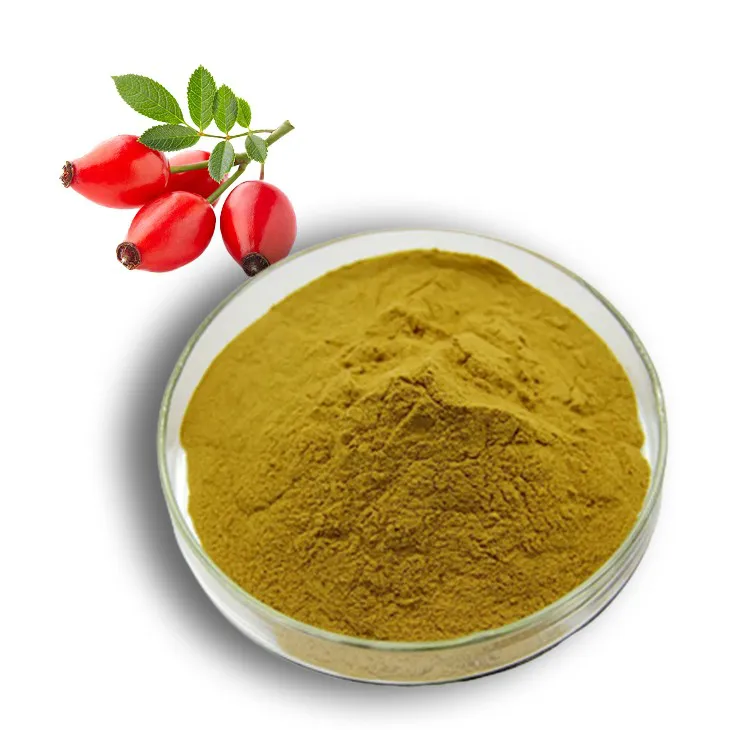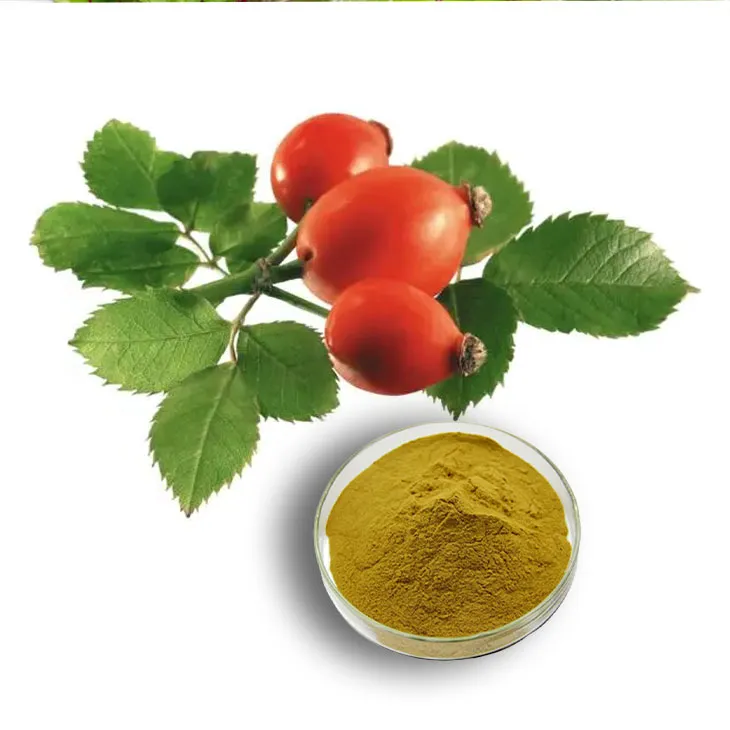- 0086-571-85302990
- sales@greenskybio.com
The process of extracting rose hip vitamin C complex from rose hip extract.
2024-11-29

1. Introduction to Rose Hip and Its Vitamin C Complex
Rose hips are the fruit of the rose plant, and they are rich in various nutrients. The vitamin C complex found in rose hips is of particular significance. Vitamin C is well - known for its antioxidant properties, which play a crucial role in maintaining human health. In rose hips, the vitamin C complex is not only a simple form of ascorbic acid but also includes other related compounds that may enhance its bioavailability and antioxidant effects.
Rose hips also contain other beneficial components such as flavonoids, carotenoids, and essential fatty acids. These components may work in synergy with the vitamin C complex, further contributing to its potential health - promoting effects. For example, flavonoids can enhance the stability of vitamin C and may also have their own antioxidant and anti - inflammatory properties.

2. Extraction Techniques
2.1 Solvent Extraction
Solvent extraction is one of the most commonly used methods for extracting the vitamin C complex from Rose Hip Extract.
- First, the rose hips are dried and ground into a fine powder. This step is important as it increases the surface area of the rose hip material, allowing for better interaction with the solvent.
- Next, a suitable solvent is selected. Commonly used solvents include ethanol, methanol, or a mixture of water and organic solvents. Ethanol is often preferred due to its relatively low toxicity and good solubility for the target compounds.
- The ground rose hip powder is then mixed with the solvent in a specific ratio. This mixture is stirred for a certain period, usually several hours, at a controlled temperature. For example, a temperature range of 20 - 50 °C may be used depending on the nature of the solvent and the stability of the compounds.
- After stirring, the mixture is filtered to separate the liquid extract (containing the vitamin C complex) from the solid residue. The filtrate is then concentrated, either by evaporation under reduced pressure or other concentration methods, to obtain a more concentrated form of the vitamin C - rich extract.
Advantages:
- It is a relatively simple and cost - effective method. The equipment required for solvent extraction is widely available and not overly expensive.
- It can be easily scaled up for industrial production. Many existing extraction plants can be adapted to perform solvent extraction of rose hip vitamin C complex.
Disadvantages:
- The use of organic solvents may pose some safety risks, especially if not properly handled. There is a potential for solvent residues in the final product, which may be a concern for food - grade or pharmaceutical - grade applications.
- Some of the solvents may not be very selective, and they may extract other unwanted compounds along with the vitamin C complex, which may require further purification steps.
2.2 Supercritical Fluid Extraction
Supercritical fluid extraction (SFE) is a more advanced extraction technique.
- In SFE, carbon dioxide (CO₂) is most commonly used as the supercritical fluid. First, CO₂ is compressed and heated to reach its supercritical state. In this state, CO₂ has properties intermediate between a gas and a liquid, which gives it unique solvation capabilities.
- The dried and pre - treated rose hip material is placed in an extraction vessel. The supercritical CO₂ is then passed through the rose hip material at a controlled pressure and temperature. For example, typical pressure ranges may be 100 - 300 bar, and temperature ranges may be 30 - 60 °C.
- The vitamin C complex and other soluble components are dissolved in the supercritical CO₂. The extract - laden CO₂ is then passed through a separator where the pressure and/or temperature is adjusted to cause the CO₂ to return to its gaseous state, leaving behind the concentrated extract.
Advantages:
- Supercritical CO₂ is non - toxic, non - flammable, and environmentally friendly. There is no solvent residue in the final product, which is highly desirable for high - quality applications such as in the food and pharmaceutical industries.
- It offers high selectivity. By adjusting the pressure and temperature conditions, it is possible to selectively extract the vitamin C complex while leaving behind many of the unwanted compounds.
Disadvantages:
- The equipment for supercritical fluid extraction is more expensive compared to solvent extraction equipment. This high cost may limit its application in some small - scale or budget - constrained operations.
- The process is more complex and requires precise control of pressure and temperature parameters. Any deviation from the optimal conditions may result in reduced extraction efficiency or selectivity.

3. Potential in Promoting Health and Beauty
The extracted rose hip vitamin C complex has significant potential in promoting health and beauty.
Health - related benefits:
- Immune system support: Vitamin C is essential for the proper functioning of the immune system. The vitamin C complex from rose hips may help boost the immune system, making the body more resistant to infections.
- Antioxidant effects: As mentioned earlier, the vitamin C complex, along with other components in rose hips, has antioxidant properties. These antioxidants can neutralize free radicals in the body, reducing oxidative stress and potentially preventing various chronic diseases such as heart disease, cancer, and neurodegenerative disorders.
- Skin health: Vitamin C is involved in collagen synthesis. Collagen is a key protein in the skin that provides structure and elasticity. By promoting collagen production, the rose hip vitamin C complex may help improve skin health, reduce wrinkles, and promote wound healing.
Beauty - related benefits:
- In addition to its role in skin health, the vitamin C complex can also be used in cosmetic formulations. It can be added to creams, lotions, and serums to enhance the antioxidant protection of the skin and improve its overall appearance.
- Rose hip oil, which contains the vitamin C complex and other beneficial components, is often used in hair care products. It may help improve hair strength and shine, and also has potential benefits for a healthy scalp.

4. Conclusion
The extraction of the rose hip vitamin C complex from Rose Hip Extract is a process with multiple techniques available, each having its own advantages and disadvantages. Solvent extraction is a more traditional and cost - effective method, while supercritical fluid extraction offers a more environmentally friendly and selective option. The extracted complex has great potential in the fields of health and beauty, making it an important area of research and development.
FAQ:
Question 1: What is the composition of rosehip?
Rosehip is rich in various components. It contains a significant amount of vitamin C complex, which is a key part we are interested in for extraction. Additionally, it has other nutrients like flavonoids, phenolic acids, and fatty acids. These components together contribute to the potential health and beauty benefits associated with rosehip.
Question 2: Why is the vitamin C complex in rosehip important?
The vitamin C complex in rosehip plays a crucial role in many aspects. Vitamin C is well - known for its antioxidant properties. It helps in protecting the body's cells from damage caused by free radicals. In the context of health, it can boost the immune system, aid in collagen synthesis which is important for skin health, and may also have anti - inflammatory effects. In terms of beauty, it can contribute to maintaining healthy and youthful - looking skin.
Question 3: What are the advantages of solvent extraction for rosehip vitamin C complex?
Solvent extraction has certain advantages. It is a relatively straightforward and commonly used method. It can effectively extract the vitamin C complex from rosehip extract. Different solvents can be chosen based on their solubility properties, which allows for a more targeted extraction. Also, it can be scaled up relatively easily for large - scale production.
Question 4: What are the disadvantages of solvent extraction?
There are some drawbacks to solvent extraction. One major concern is the potential residue of the solvent in the final product, which may pose a risk to health if not completely removed. Moreover, some solvents may also extract unwanted components along with the vitamin C complex, leading to a less pure final product. The process may also be time - consuming and may require additional steps for purification.
Question 5: How does supercritical fluid extraction work for rosehip vitamin C complex?
Supercritical fluid extraction uses a supercritical fluid, typically carbon dioxide. The supercritical state has properties between a gas and a liquid. It can penetrate the rosehip extract effectively and selectively extract the vitamin C complex. Since carbon dioxide is non - toxic and easily removable, it can result in a relatively pure product. The extraction is often carried out under controlled pressure and temperature conditions to optimize the process.
Related literature
- The Composition and Health Benefits of Rosehip Extracts"
- "Extraction Techniques for Bioactive Compounds from Rosehip: A Review"
- "Rosehip Vitamin C Complex: Properties and Applications in Health and Beauty"
- ▶ Hesperidin
- ▶ Citrus Bioflavonoids
- ▶ Plant Extract
- ▶ lycopene
- ▶ Diosmin
- ▶ Grape seed extract
- ▶ Sea buckthorn Juice Powder
- ▶ Fruit Juice Powder
- ▶ Hops Extract
- ▶ Artichoke Extract
- ▶ Mushroom extract
- ▶ Astaxanthin
- ▶ Green Tea Extract
- ▶ Curcumin
- ▶ Horse Chestnut Extract
- ▶ Other Product
- ▶ Boswellia Serrata Extract
- ▶ Resveratrol
- ▶ Marigold Extract
- ▶ Grape Leaf Extract
- ▶ New Product
- ▶ Aminolevulinic acid
- ▶ Cranberry Extract
- ▶ Red Yeast Rice
- ▶ Red Wine Extract
-
Nettle Root Extract
2024-11-29
-
Ginseng Root Extract
2024-11-29
-
Dandelion Root Extract
2024-11-29
-
Red Vine Extract
2024-11-29
-
Jujube Extract
2024-11-29
-
Artichoke Leaf Extract
2024-11-29
-
Giant Knotweed Extract
2024-11-29
-
Saffron Extract Powder
2024-11-29
-
Camu Camu Extract
2024-11-29
-
Clove Powder
2024-11-29





















